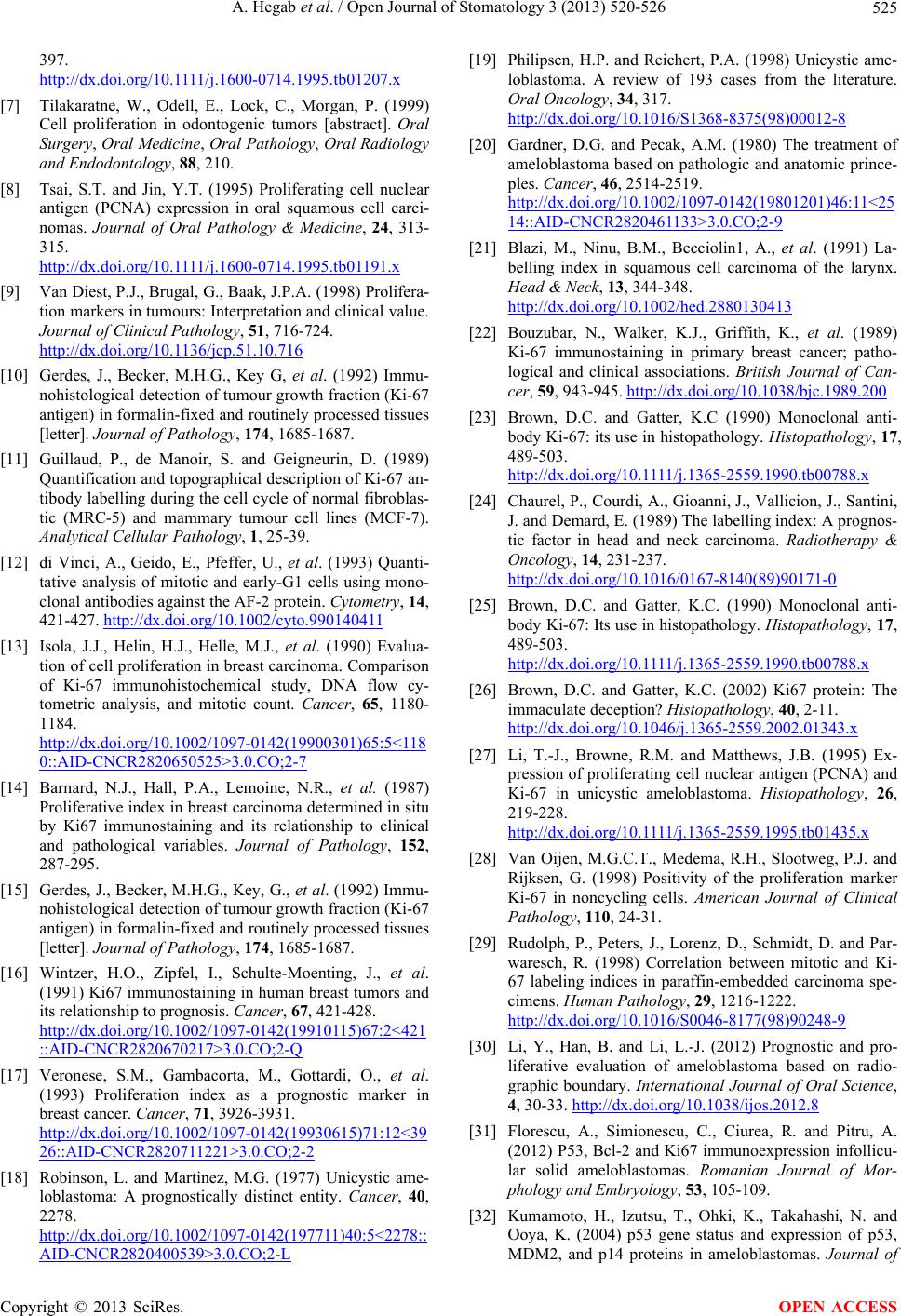
A. Hegab et al. / Open Journal of Stomatology 3 (2013) 520-526 525
397.
http://dx.doi.org/10.1111/j.1600-0714.1995.tb01207.x
[7] Tilakaratne, W., Odell, E., Lock, C., Morgan, P. (1999)
Cell proliferation in odontogenic tumors [abstract]. Oral
Surgery, Oral Medicine, Oral Pathology, Oral Radiology
and Endodontology, 88, 210.
[8] Tsai, S.T. and Jin, Y.T. (1995) Proliferating cell nuclear
antigen (PCNA) expression in oral squamous cell carci-
nomas. Journal of Oral Pathology & Medicine, 24, 313-
315.
http://dx.doi.org/10.1111/j.1600-0714.1995.tb01191.x
[9] Van Diest, P.J., Brugal, G., Baak, J.P.A. (1998) Prolifera-
tion markers in tumours: Interpretation and clinical value.
Journal of Clinical Pathology, 51, 716-724.
http://dx.doi.org/10.1136/jcp.51.10.716
[10] Gerdes, J., Becker, M.H.G., Key G, et al. (1992) Immu-
nohistological detection of tumour growth fraction (Ki-67
antigen) in formalin-fixed and routinely processed tissues
[letter]. Journal of Pathology, 174, 1685-1687.
[11] Guillaud, P., de Manoir, S. and Geigneurin, D. (1989)
Quantification and topographical description of Ki-67 an-
tibody labelling during the cell cycle of normal fibroblas-
tic (MRC-5) and mammary tumour cell lines (MCF-7).
Analytical Cellular Pathology, 1, 25-39.
[12] di Vinci, A., Geido, E., Pfeffer, U., et al. (1993) Quanti-
tative analysis of mitotic and early-G1 cells using mono-
clonal antibodies against the AF-2 protein. Cytometry, 14,
421-427. http://dx.doi.org/10.1002/cyto.990140411
[13] Isola, J.J., Helin, H.J., Helle, M.J., et al. (1990) Evalua-
tion of cell proliferation in breast carcinoma. Comparison
of Ki-67 immunohistochemical study, DNA flow cy-
tometric analysis, and mitotic count. Cancer, 65, 1180-
1184.
http://dx.doi.org/10.1002/1097-0142(19900301)65:5<118
0::AID-CNCR2820650525>3.0.CO;2-7
[14] Barnard, N.J., Hall, P.A., Lemoine, N.R., et al. (1987)
Proliferative index in breast carcinoma determined in situ
by Ki67 immunostaining and its relationship to clinical
and pathological variables. Journal of Pathology, 152,
287-295.
[15] Gerdes, J., Becker, M.H.G., Key, G., et al. (1992) Immu-
nohistological detection of tumour growth fraction (Ki-67
antigen) in formalin-fixed and routinely processed tissues
[letter]. Journal of Pathology, 174, 1685-1687.
[16] Wintzer, H.O., Zipfel, I., Schulte-Moenting, J., et al.
(1991) Ki67 immunostaining in human breast tumors and
its relationship to prognosis. Cancer, 67, 421-428.
http://dx.doi.org/10.1002/1097-0142(19910115)67:2<421
::AID-CNCR2820670217>3.0.CO;2-Q
[17] Veronese, S.M., Gambacorta, M., Gottardi, O., et al.
(1993) Proliferation index as a prognostic marker in
breast cancer. Cancer, 71, 3926-3931.
http://dx.doi.org/10.1002/1097-0142(19930615)71:12<39
26::AID-CNCR2820711221>3.0.CO;2-2
[18] Robinson, L. and Martinez, M.G. (1977) Unicystic ame-
loblastoma: A prognostically distinct entity. Cancer, 40,
2278.
http://dx.doi.org/10.1002/1097-0142(197711)40:5<2278::
AID-CNCR2820400539>3.0.CO;2-L
[19] Philipsen, H.P. and Reichert, P.A. (1998) Unicystic ame-
loblastoma. A review of 193 cases from the literature.
Oral Oncology, 34, 317.
http://dx.doi.org/10.1016/S1368-8375(98)00012-8
[20] Gardner, D.G. and Pecak, A.M. (1980) The treatment of
ameloblastoma based on pathologic and anatomic prince-
ples. Cancer, 46, 2514-2519.
http://dx.doi.org/10.1002/1097-0142(19801201)46:11<25
14::AID-CNCR2820461133>3.0.CO;2-9
[21] Blazi, M., Ninu, B.M., Becciolin1, A., et al. (1991) La-
belling index in squamous cell carcinoma of the larynx.
Head & Neck, 13, 344-348.
http://dx.doi.org/10.1002/hed.2880130413
[22] Bouzubar, N., Walker, K.J., Griffith, K., et al. (1989)
Ki-67 immunostaining in primary breast cancer; patho-
logical and clinical associations. British Journal of Can-
cer, 59, 943-945. http://dx.doi.org/10.1038/bjc.1989.200
[23] Brown, D.C. and Gatter, K.C (1990) Monoclonal anti-
body Ki-67: its use in histopathology. Histopathology, 17,
489-503.
http://dx.doi.org/10.1111/j.1365-2559.1990.tb00788.x
[24] Chaurel, P., Courdi, A., Gioanni, J., Vallicion, J., Santini,
J. and Demard, E. (1989) The labelling index: A prognos-
tic factor in head and neck carcinoma. Radiotherapy &
Oncology, 14, 231-237.
http://dx.doi.org/10.1016/0167-8140(89)90171-0
[25] Brown, D.C. and Gatter, K.C. (1990) Monoclonal anti-
body Ki-67: Its use in histopathology. Histopath o lo g y, 17,
489-503.
http://dx.doi.org/10.1111/j.1365-2559.1990.tb00788.x
[26] Brown, D.C. and Gatter, K.C. (2002) Ki67 protein: The
immaculate deception? Histopathology, 40, 2-11.
http://dx.doi.org/10.1046/j.1365-2559.2002.01343.x
[27] Li, T.-J., Browne, R.M. and Matthews, J.B. (1995) Ex-
pression of proliferating cell nuclear antigen (PCNA) and
Ki-67 in unicystic ameloblastoma. Histopathology, 26,
219-228.
http://dx.doi.org/10.1111/j.1365-2559.1995.tb01435.x
[28] Van Oijen, M.G.C.T., Medema, R.H., Slootweg, P.J. and
Rijksen, G. (1998) Positivity of the proliferation marker
Ki-67 in noncycling cells. American Journal of Clinical
Pathology, 110, 24-31.
[29] Rudolph, P., Peters, J., Lorenz, D., Schmidt, D. and Par-
waresch, R. (1998) Correlation between mitotic and Ki-
67 labeling indices in paraffin-embedded carcinoma spe-
cimens. Human Pathology, 29, 1216-1222.
http://dx.doi.org/10.1016/S0046-8177(98)90248-9
[30] Li, Y., Han, B. and Li, L.-J. (2012) Prognostic and pro-
liferative evaluation of ameloblastoma based on radio-
graphic boundary. International Journal of Oral Science,
4, 30-33. http://dx.doi.org/10.1038/ijos.2012.8
[31] Florescu, A., Simionescu, C., Ciurea, R. and Pitru, A.
(2012) P53, Bcl-2 and Ki67 immunoexpression infollicu-
lar solid ameloblastomas. Romanian Journal of Mor-
phology and Embryology, 53, 105-109.
[32] Kumamoto, H., Izutsu, T., Ohki, K., Takahashi, N. and
Ooya, K. (2004) p53 gene status and expression of p53,
MDM2, and p14 proteins in ameloblastomas. Journal of
Copyright © 2013 SciRes. OPEN ACCESS